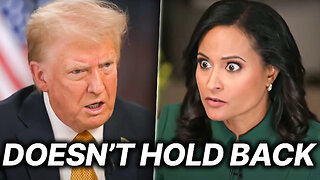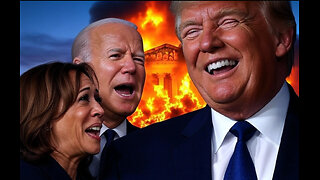Premium Only Content

Is Your Bank Going to Survive? | The Gold Standard 2408
https://www.midasgoldgroup.com/
Jennifer Horn and Ken Russo explore the alarming trends plaguing the banking sector, from unrealized losses to bonds losing significant value and commercial real estate facing occupancy challenges. If many customers start withdrawing their funds, banks are at the risk of insolvency. With six banks collapsing last year and many more on the watch list, including major players like JPMorgan Chase, City Bank, Goldman Sachs, Bank of America, and Morgan Stanley, who collectively control 83% of all US banks’ financial derivatives, this episode explores the vulnerabilities within the banking system.
The episode begins with Ken Russo’s historical overview, tracing the trajectory from Nixon’s pivotal decision to abandon the gold standard in 1971. This move unfettered the Federal Reserve, enabling unchecked money printing and rampant government spending, setting the stage for today’s economic uncertainties.
Shockwaves still ripple through the financial industry since last year’s losses at JPMorgan Chase. It raises concerns about the stability of one of the largest and riskiest banks in the United States. In May, the Federal Deposit Insurance Corporation announced the failure of First Republic Bank, later sold to JPMorgan Chase. The deal between JPMorgan Chase and the FDIC included significant concessions, such as the FDIC shouldering 80 percent of losses on single-family residential mortgages for seven years and commercial loans for five years. This arrangement not only underscored the precarious position of JPMorgan Chase but also highlighted the bank’s desperate need for deposits. Despite the influx of deposits from First Republic Bank, JPMorgan Chase continued to experience significant outflows, losing a staggering $248.38 billion in deposits over the last seven quarters. With billions of dollars in uninsured deposits and mounting pressure from regulators, JPMorgan Chase and other banks face a challenging road ahead as it grapples with its deposit instability.
In modern banking, the fractional reserve system stands as a cornerstone, facilitating lending and economic growth by efficiently allocating deposited funds. Yet, as the system relies on banks only holding a fraction of customer deposits in reserve, questions arise about its stability and the security of deposited funds. While this system has historically been pivotal in spurring economic growth, it also poses inherent risks, particularly in financial instability or widespread loss of confidence in the banking sector.
With such considerations in mind, it’s prudent for individuals to explore avenues to safeguard their savings against potential risks within the banking system. One such route is diversifying a portion of cash savings into tangible assets like precious metals, such as gold and silver. Unlike fiat currency, subject to the fluctuations of monetary policy and the banking system, precious metals have intrinsic value and serve as a hedge against economic uncertainty and inflation. By holding physical gold or silver, individuals can protect their wealth from erosion caused by inflation or a depreciating currency.
The prospect of separating the creation of money from financial intermediation underscores the need for alternative stores of value outside the traditional banking system.
Inflation poses a significant threat to the purchasing power of savings deposits as the dollar’s value steadily erodes over time. While savings accounts offer a secure option for storing cash, the interest rates typically fail to keep pace with inflation. As a result, the real value of savings diminishes, effectively making individuals poorer in terms of their ability to purchase goods and services. While federally insured accounts protect deposits up to $250,000 per depositor, per ownership category, it’s important to recognize that simply stashing cash in a savings account may not be enough to safeguard against inflationary pressures.
As the debate surrounding the future of banking continues, diversifying into precious metals offers a tangible solution for individuals seeking to fortify their financial resilience in an evolving economic landscape. As custodians of their financial well-being, individuals must assess the risks inherent in the banking system and consider prudent strategies to preserve and grow their wealth over the long term.
In this context, allocating a portion of savings into precious metals emerges as a viable strategy to mitigate risks associated with fractional reserve banking and safeguard against potential economic downturns.
___________________________________________________________________________________________________
Gold IRA: https://www.midasgoldgroup.com/gold-ira/
Invest in Gold: https://www.midasgoldgroup.com/buy-gold/
Guide to Owning Bullion & Coins: https://www.midasgoldgroup.com/bullion-guide/
Read the latest precious metals news: https://www.midasgoldgroup.com/news/
-
 25:04
25:04
Midas Gold Group
3 months agoA Collapse or a Reset? | The Gold Standard 2435
451 -
 2:54:24
2:54:24
Fed Reacts
12 hours agoFormer Fed Explains Lil Durk's Second Murder For Hire
84K30 -
 44:13
44:13
barstoolsports
18 hours agoThe Shred Line with Coach Gruden, Dave Portnoy and Steven Cheah | Week 17
137K13 -
 2:24:54
2:24:54
WeAreChange
15 hours agoTrump Sides With Musk On Visas! MAGA Base ENRAGED??
106K98 -
 2:04:26
2:04:26
Nerdrotic
15 hours ago $34.00 earnedThe Program: The Government's UFO Cover Up Programs | Forbidden Frontier #085
81.9K27 -
 2:13:07
2:13:07
vivafrei
17 hours agoEp. 243: HOLIDAY SPECIAL! The Great H1B Visa Debate! Jay z Gets Scorched! Attack in Germany! & MORE!
157K356 -
 16:40
16:40
Russell Brand
19 hours agoTHIS MASSIVELY BACKFIRED...
204K694 -
 25:41
25:41
SB Mowing
23 hours agoPICTURE living next to THIS and not knowing what to do…
161K82 -
 2:16:01
2:16:01
George Galloway
1 day agoNEW YEAR COUNTDOWN - MOATS with George Galloway - EP 408
152K253 -
 18:39
18:39
Stephen Gardner
19 hours ago🔥BREAKING! Trump's SHOCKING New Demand | Biden admits DOJ TARGETED Trump Illegally!
117K512